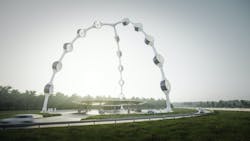Wind-powered microgrids are relatively rare, but two companies — CleanSpark and FlowGen — have inked a deal to change that.
FlowGen, a wind turbine technology company based in Switzerland, has agreed to use CleanSpark’s mPulse controls in all of its microgrid projects across the globe. CleanSpark was granted exclusive distribution rights for FlowGen’s wind turbine solutions in North and South America.
Wind power can add value to microgrids in locations where there isn’t much room for solar. That includes telecom operations, cell towers and data centers, said Zach Bradford, CEO of microgrid company CleanSpark. However, he expects solar to be incorporated into about 70% of the wind-powered microgrids. If there’s space for solar, the company wants to take advantage of it, along with wind.
With the new deal, the two companies hope to boost the number of green microgrids worldwide.
“CleanSpark brings the missing part to us, their IT solutions and experience of the market needs in the USA, and we bring the missing part to them,” said Dirk Kuester, FlowGen CEO and founder, referring to FlowGen providing wind turbines and its experience in Europe. “Together we bring a 360 degree solution to the market.”
Lessons from car racing
Bradford said he’s excited the partnership will give the company a larger worldwide reach.
“They [FlowGen] have a small footprint in Europe. We are a public company with access to capital. The expectation is that we will lead the charge in the Americas. And they will lead sales initiatives in Europe and Asia, and we’ll have a worldwide reach.”
CleanSpark chose FlowGen as its partner because of its technology, which is based on the same principles Kuester used when he worked in the car racing industry, said Bradford. Applying Kuester’s experience in auto racing to the wind industry allows FlowGen to have a competitive advantage, Bradford added. The turbine turns more efficiently than other turbines at low and high speeds, he said.
“It’s efficient due to aerodynamic principles. Our approach is not to put up giant 1-MW turbines, but smaller turbines that are more efficient and have a smaller footprint,” said Bradford.
“Our approach is not to put up giant 1-MW turbines, but smaller turbines that are more efficient and have a smaller footprint ” — Zach Bradford, CleanSpark
When Kuester was in the car racing industry, he focused on mass production processes, simulation tools and worked with a team that specialized in aerodynamics, he said. His company used the same structure and tools to achieve maximum efficiencies in its wind turbine systems. After achieving high efficiencies, the company also developed a durable material for wind turbines using mass production systems based on the car industry, he added.
CleanSpark also has an unusual story about its involvement in renewable energy. Its success in Bitcoin mining — an energy intensive effort — has allowed the company to build its microgrid business more quickly and boost its reach.
In 2018, CleanSpark designed and engineered a microgrid for a stand-alone mobile Bitcoin mining station and now has 23 mobile mining rigs as part of its complex in Atlanta.
Greening Bitcoin mining
Bradford is quick to point out that the energy used for its Bitcoin mining is 95% nuclear and carbon free. The company wants to add renewable energy at its Bitcoin mining facilities in Atlanta to move to 100% carbon free energy. CleanSpark expects to be 98% carbon free by summer and 100% carbon free by the end of the year. The company is now looking at whether its Atlanta site can accommodate wind power.
The company aims to help energy intensive Bitcoin miners reduce their carbon footprints. The plan is to work with large miners — those that need 10 MW to 100 MW of power.
“Helping Bitcoin miners improve their energy mix is in demand. Our goal is to take renewable sources and help them on-site,” said Bradford.
While CleanSpark is now seen mostly as a software provider, it also offers turnkey microgrids, mostly powered by solar to date. It will add wind to these offerings, using only microgrids with FlowGen wind turbines for turnkey systems.
The company has also offered turnkey solutions to the military in the past, but now wants to build up this part of its business.
FlowGen encouraged by Biden administration
Meanwhile, FlowGen is looking forward to helping build a greener planet with the Biden administration’s leadership.
“With President Biden, I believe America will again be the flagship model on how to do it better and faster — building a greener planet. We will do our small part to support this,” said FlowGen’s Kuester.
Track news about wind-powered microgrids. Subscribe to the free Microgrid Knowledge Newsletter.








